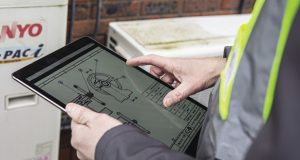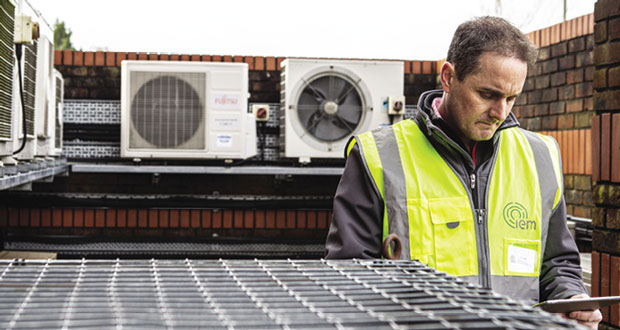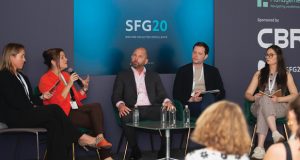CLIENT NEEDS
IEM primarily works with clients who have been ‘yellow paging’ it or have tried working with the bigger companies but find they are just a number within that company. The aim is to get them to a position where they know their assets, they know their condition, their compliance position and they have a priorities list to meet. That may involve support based on the 5-point plan where IEM will work with them over 12 to 18 months until they’re ready to go to tender or they can choose to stay with the company.
“That’s one of our core routes to market,” says Scott. “We’ve also worked hard with our internal team on our framework, determining what we want to be known for and that’s allowed us to introduce things like the client’s health check.”
This three-tier process starts with an hour’s zoom to go through key compliance areas, such as fire, gas and water, giving clients information on where they are on a score system. If clients want a bit more help, IEM can go in and carry out an audit that can range from a half day to a five-day process.
“With some, we work on a consultancy role sitting between them and the services provider and adding clarity,” says Scott. “It’s all about our own learning too, as the more clients we engage with the more we’re going to learn, and add even more value.”
Scott believes strongly that understanding client needs means making even the most complex engineering or asset management solutions accessible. With FM being such a broad church and many coming in from a soft services side, not being blinded by science when it comes to meeting M&E objectives is important.
“Buildings are probably the largest asset an organisation will have and therefore our job is in making it easier for the client to understand what is required. We all know how to look after cars, we need an MOT etc., to go out on the road. It’s exactly the same with buildings, but often is made so complex.
“Most people don’t know what goes into an MOT, but we do know we need that certificate. In a similar way we are engaged to ensure your building and the people in them are kept safe and secure. This is why we turn up and discuss how we can enable you to achieve the aims of the organisation.”
As an example – a potential client was taking their M&E contracts to tender, but it was clear they could do it differently.
“We had all the supply chain lined up and the technical expertise to give them a level of control and a vision to see how much the spend is and that it is all in one place. This removes that old school approach of tendering at cost. We go in and ask, ‘what are you looking to achieve and how much have you got to play with?’ We’ll act as your interim between that contractor and management.
“That point of difference allows us to play in the field and while we’re engaging with the clients we give them that personable touch as we aim to understand and enable.”
POST-COVID CHALLENGES
Commercial estates management looks set to face a whole new set of challenges as many organisations look to adopt hybrid working patterns. Scott advises that they start with the basics: “Where are you in the lease pattern? What would it cost to return that building early? What does that disposal cost look like and what would an enhancement cost be? This goes back to really getting into the detail with the client to understand what they are looking to achieve and then assisting them in making the right decision.”
Scott believes that IoT solutions will play a huge part in the future in helping manage estates; whether it’s using a noise sensor to carry out a generator test or pressure sensors to ensure lifts go to the right areas. A healthcare client is currently adopting air quality sensors that monitor surgical areas to check on the air quality.
 The result of utilising digital solutions is also the rich stream of data they produce, but many FMs are uncertain on what is useful and what is white noise. This is another area that Scott feels strongly should be simplified.
The result of utilising digital solutions is also the rich stream of data they produce, but many FMs are uncertain on what is useful and what is white noise. This is another area that Scott feels strongly should be simplified.
“Data is absolutely critical and there are a lot of systems out there that can gather all the data but it’s how you review and use that data which is key. Ask, what are we looking to measure and why do we need to measure this?
“We work with a simplistic data overview, because we could produce figures for everything, from meantime until failure or the potential spend on certain areas, but that equals a lot of unnecessary detail.
“Instead on a daily basis we give clients the key enablers, what’s working, what’s costing them time or loss of trading, what the spend is to date and where they are against plan.
“We find that goes down really well, because should they ask a question e.g. ‘when was the last time that piece of equipment failed?’, we can tell them but we don’t bombard with lots of data because very quickly you can get lost.”
FUTURE TALENT
A huge challenge for the sector going forward is the skills shortage. It’s been estimated that 20–30 per cent of all UK engineers are employed in FM, but the UK faces an engineering skills shortage. IEM is dealing with this is by engaging with the supply chain regularly and working with contractors on a tiered regional basis using local contractors to deliver services. This also of course ticks the sustainability box.
“Long term I feel strongly that apprenticeships are important,” says Scott. “Engineering hasn’t been supported for years in this country so what we need to do as an industry is help the government understand what FM is in the first place as their daily interactions are numerous. Going back to where I started, there is also the military which offers a pool of self-motivated engineers ready to come out and go into industry. A lot of service leavers struggle with that transition but we’re ready to take them on.”
With the economy opening up, Scott is seeing a lot of opportunities for IEM to build on relationships that were nurtured in supporting clients through the pandemic. Says Scott: “As organisations make plans for the future, we’ve been engaging with them to understand how we can help and how we can add value. We’ve also just brought in our new MD Derrick Hidden from CloudFM. He brings a wealth of knowledge with him and along with some other team moves we’ve made we are really in a great place to move forward.
“This sector is finally getting to the top table, whether that’s in returning to work, or whether it’s in dilapidations and moving them on. We want to add value to the FMs and property directors so they’re winning board recognition. When you look at it from a monetary value, FM often holds the biggest budget and the greatest risk. So within that we want to help move from risk and cost to value added.”





